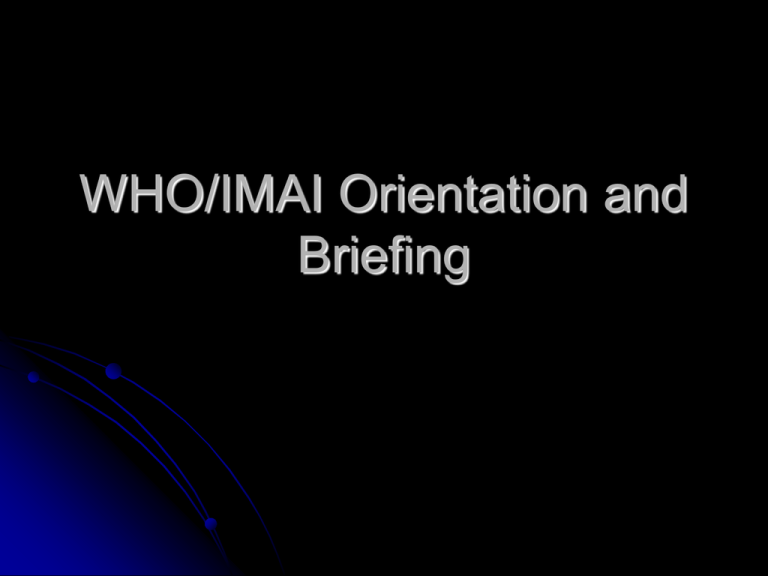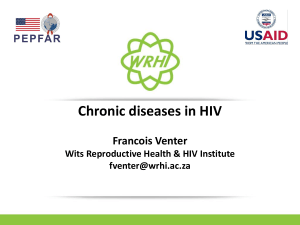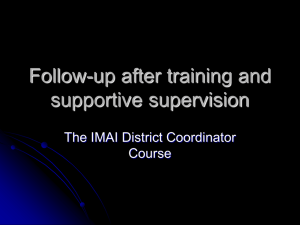
WHO/IMAI Orientation and
Briefing
Challenges of rapid scale-up of ART
HIV: multi-system disease
Requires shift to chronic care
Comprehensive care: acute, chronic,
palliative; with/without, before/after ART
Clinical team approach
Clinical interventions for public health
Standardized generic guidelines for country
adaptation
Focus on priority problems
Provides tools (guidelines, training, patient
monitoring, management materials) for country
adaptation and use
Simplified for use at district and health centre
level (first-level outpatient facilities)
Symptom-based but also integrates important,
available lab tests
HIV-relevant pocket guides
(guideline modules)
Key Features of IMAI
Flexible service delivery model
Supports rapid scale up—aimed at
achieving broad coverage of key
interventions—required for scaling-up
Harmonization, simplification and
standardization
Simple and practical but comprehensive
Coherent & consistent, rather than
fragmented & inconsistent—package
Based on WHO ART guidelines:
(Product of global consultation)
HIV/AIDS
STANDARD
TREATMENT
GUIDELINES
Scaling-up HIV services
ART
Hospital
Health
Centre
Health
Centre
Health
Centre
Health
Centre
Clinic Clinic Clinic Clinic Clinic Clinic Clinic Clinic Clinic Clinic Clinic Clinic
Tony Harries, Malawi:
The “medicalised model” in Africa
Doctors to deliver ARV treatment
Choice of multiple ARV regimens
Mandatory laboratory monitoring
“LFTs, FBC, CD4-counts”
Computers to track patient follow-up
will preclude rapid and massive scale up
Chronic HIV Care
Hospital
Health
Centre
Health
Centre
ART
Health
Centre
Health
Centre
Health Health Health Health Health Health Health Health Health Health Health Health
Post Post Post Post Post Post Post Post Post Post Post Post
PMTCT
Hospital
Health
Centre
Health
Centre
Health
Centre
Health
Centre
Health Health Health Health Health Health Health Health Health Health Health Health
Post Post Post Post Post Post Post Post Post Post Post Post
Spectrum of HIV related services
HIV uninfected
Not sexually
active
Sexually active
HIV infected
Asymptomatic Advanced
+ Home based &
Palliative care
+ ART and OI management
+ ARV for Prevention (MTCT)
Psychosocial care, livelihood support, P4P
HIV testing
+ Info, prevention and care services
(Pregnancy, STI, substance use and PEP)
Information, life skills & community based interventions to:
raise awareness of HIV, reduce IDU & stigma & promote services
Testing and Counselling
Hospital
Health
Centre
Health
Centre
Health
Centre
Health
Centre
Health Health Health Health Health Health Health Health Health Health Health Health
Post Post Post Post Post Post Post Post Post Post Post Post
Basic prevention for ALL:
• Safer sex/condoms
• STI screen, get treated
• Dual protection FP
• Test and get family/
partners tested
Peer outreach
sex workers, IDU,
adolescents
Focused
prevention
Illness:
HIV negative and
positive
Severe
illness
PLHA support
Positive
prevention
Integrated Management
of Prevention, Care and Treatment
In the community
Treatment Preparedness
Strengthen prevention
HIV T&C
Know your
status
Treatment
Supporters
Prevention
IMAI Acute Care
At first-level health facility
IMAI Chronic HIV Care
with ART
IMAI/IMCI: Second level
ART/OI & HIV inpatient
management
At district hospital
Basic prevention for ALL
delivered in community:
• Safer sex/condoms
• STI screen, get treated
• Promote dual protection FP
• Test and get family/
partners tested
Integrated Management
of Prevention, Care and Treatment
in the community
WHO IMAI
PLHA:
Prevention for positives
•Prevention by positives
•Peer groups for
treatment support
Patient Education
Flipchart on HIV
prevention section
Patient SelfManagement
&
Caregiver
Booklet
Patient Treatment
Cards–prevention on
back
Adolescents
CHWs:
Treatment support
Prevention
Community-based
preparation of
Treatment
Supporters by CHWs
ClientInitiated
T&C:
Know your
status
Sex
Workers
IDU
Peer outreach/Focused prevention
Prevention
Treatment Preparedness: Community education on ART; Community adherence support
Strengthen prevention
Palliative
Adult
illness:
IMAI Palliative
Care
Pregnant
women
HIV negative
and positive
IMAI Acute Care
Adult
illness:
Acute
HIV negative
and positive
Routine
HIV T&C
Sex
worker
Adolescent
IDU
Job
Aid
IMCI-HIV
Adaptation
Child illness:
HIV negative and
positive
TB:
Chronic- all ages
HIV negative
and
positive
Routine
HIV T&C
PMTCT integrated
Routine
within
Antenatal, HIV T&C
Post-partum Care
Safer Labour &
Deliver
FP visits
PMTCT:
FP: dual protection
For positives:
Reproductive choice
Return to sexuality
Routine
HIV T&C
Reproductive Health
Routine
HIV T&C
PMTCT:
Infant feeding
counselling
ARV prophylaxisTaught within
Chronic HIV Care with
ART
IMAI TB Care
with TB-HIV
Co-Management
Routine
HIV T&C
PLHA
IMAI Chronic
HIV Care
with ART
Integrated Management
of Prevention, Care and Treatment
At first-level health facility
Clinical mentoring
Referral/back-referral
Severe
adult
illness
Acute & chronic
Severe
child
illness
Basic prevention for ALL:
•Safer sex/condoms
•STI screen, get treated
•Dual protection FP
•Test and get family/
partners tested
Routine
HIV T&C
IMAI/IMCI:
Second level
ART/OI – MD/MO &
HIV inpatient
managementMD/MO; nursing
TB
disease
Pregnant
Women
with
complications
Routine
HIV T&C
PMTCT:
Safer labour and delivery
in hospital
Reproductive Health
TB treatment by
MD/MOCo-treatment decisions,
etc.
Regular Clinical
Supervision/
Communication by MD/ MO
on clinical team
Integrated Management of
Prevention, Care and Treatment
At district hospital
Extending HIV Care/ART beyond
the hospital
HIV/AIDS care and treatment should be made
available as close to the patient’s homes as
possible—for equity, access, adherence
Most OIs can be treated in primary care facilities
IMAI Acute Care prepares for non-hospital
management of non-severe pneumonia, oral &
some oesophageal thrush, most skin infections,
persistent diarrhoea, peripheral neuropathy, etc
Decentralization of HIV services
Clinic
HIV testing and counselling
Education and counselling
PMTCT
Chronic HIV Care (OI
prophylaxis and ART)
Preparation for ART
Initiation of ART in
uncomplicated patients
ART dispensing and follow-up
Record-keeping of all the
above activities
Health centre and hospital
Initiation of ART in sick and
hospitalized patients
Management of complicated
OI cases
Management of treatment
failure and adverse effects
Management of complications
of ART
Record-keeping of all the
above activities
IMAI principles for scaling up integrated
HIV prevention, treatment and care
Establish good chronic HIV care with clinical teams working within a
district network (linking the several levels of care).
Strong PLHA and community involvement.
Empower patients for self-management.
Adapt and broadly implement a coherent, standardized package of
interventions.
Decentralize most interventions to the health centre and community
to head toward universal access.
This involves further simplification and operationalization of guidelines, harmonized training materials, and
emphasis on follow-up after training (both clinical mentoring and supportive supervision).
Rigorous and coordinated approach to adherence.
- by clinical team, community, and one-to-one treatment support in the home.
Integrate prevention with treatment and care in the facility.
Use broad-based community interventions for prevention, treatment
preparedness, and to promote use of services.
Target prevention efforts where most transmission occurs. This
requires peer outreach and special, friendly health services for high
risk and vulnerable groups.
Emphasis on management training at support at district, regional
and national level.
Countries which have
started IMAI adaptation
Uganda*
Swaziland*
Eritrea*
Senegal*
Sudan*
South Africa (Eastern Cape
Province)*
Ethiopia*
Zambia*
Lesotho*
Burkina Faso*
Guinea-C*
Tanzania*
India
China
Somalia
Mozambique
Burundi
Cameroon
Zimbabwe
Ghana
Namibia
Botswana
PNG
Nigeria
Indonesia
Haiti
Kenya
Myanmar
* adaptation complete
Home:
•Positive prevention
•Positive
prevention
•Universalprecautions
•Universal
precautions
•ART,TB
•ART,
TBone-to-one
one-to-one
treatment
treatment support
support
•Psychosocial
•Psychosocial
support
support
•Home-basedpalliative
•Home-based
palliative
care
care
IMAI/IMCItools:
tools
Example of operational
to support service
Integrated
Levels of of
interventions
Management
HIV/AIDS
delivery at
Facility with Linked
PatientInterventions
self-management
Community
tools;
caregiver booklet
(based on
IMAI/IMCI/IMPAC)
Community (above plus):
•CHWs: adherence, monitor, refill ART, TB, OI prophylaxis; prevention:
safer sex, condoms, FP; nutritional support
•HIV testing and counseling (CITC/VCT)
•Targeted interventions (outreach)—SW, IDU, other
•Broad-based prevention (emphasis on youth)
•Community mobilization for prevention, treatment
preparedness, use of services
CHW training;
peer groups
Education flipchart
Health centre (above plus):
•Provider-initiated T&C
•PEP—occupational, non-occupationalTB Care with TB-HIV
Co-Management,
•PMTCT
•Safe medical injections
Chronic HIV Care with ART,
•STI detection and treatment
Acute Care-adult, child (IMCI)
•Special care: IDU, sex worker; youth-friendly
Harmonized short courses
•Initiate first-line ART in uncomplicated patients
•TB treatment, TB-HIV Co-management
•Treat most OIs
•Integrate prevention with treatment, care
Hospital (above plus):
•IDU: drug substitution
•Blood safety
•ART in complicated patients, second-line, IRIS, severe toxicity
•TB: smear negative, extrapulmonary, TB-ART co-management
•Complicated OIs
Second-level
ART/OI training,
Clinical mentoring
3 levels/approaches to community
Integrated management of HIV/AIDS at facility
with linked community interventions:
prevention, treatment and care (IMAI/IMCI)
Systems for facility-community links: home visits,
trace patients, monitoring, refills, back-up to homebased care
CHW training
Peer support groups- trained facilitators
Use of same patient education flipchart
Caregiver booklet
Targeted community interventions with
outreach: sex workers, IDU, MSM, others
Broad-based community prevention and
treatment preparedness







